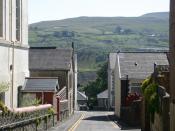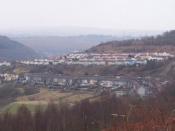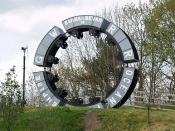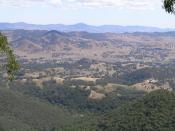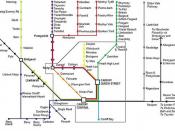References:Used "Wider World" GCSE Geography Text Book by David WaughUntil the Mid Nineteen Century, South Wales were known for its natural beauty. Artist found the valleys an ideal place to paint, but not long, businessmen also found it an ideal place ÃÂ but for industries. The industrial revolution converted the South Wales Valleys into the worldÃÂs factory of coal and iron ore. The raw materials on the valleys brought industries to Wales. Soon coal mining and iron industries became a dominate activity and that did indeed continue into the 20th century. The painting on the left shows the South Whales valleys, before industrialization.
Businessmen saw this as an opportunity to make loads of profit. This was also a very convenient business to operate, as iron stone, lime stone, and coal could be found in close proximity, together on the valley sides or nearby by. The raw materials could then be exported directly form their coastal ports to many parts of the world.
The industry was growing in such a monstrous pace that by 1850, there were 35 ironworks in the area.
As Britain was the first country to industrialize, so she had a huge market to sell to. They received longer and longer order lists from countries such as New Zealand, America, Asia, Africa, Australia, and IndonesiaÃÂ as they generally needed iron and coal to railways and ships. As order lists began to grow and more and more businesses were set up, there was a booming demand in labor. The offer of regular wages and a promise of 10 hours of work only together with it allowing children under the age of 10 to work attracted families to migrate from places such as Cornwall, Summerset and other places from the UK. By 1920, 500000 people were reported to have migrated to the South Wales valleys. The first lot of people that migrated to South Wales built their houses on the flat area, facing the river, but not after long, these ÃÂideal spotsÃÂ ran out. High density whole villages were then constructed in linear patterns up on steep hills.
Businessmen soon found it more profitable to sell manufactured steel rather then the previously brittle iron, due to the technological improvement in iron smelting.
But why do industries go? By the 1970s there were only 2 steelworks left in South Wales. (Figure 9.7 shows how industries go) The main reason would have to be because many of the advantages that boosted the rapid growth of the industries were not seen anymore. Not only have technology overtaken men labor, the number of unskilled workers has dropped. Not to forget the British empire collapsed, meaning that a big part of BritainÃÂs market was longer there. The global production of iron ore and means that there is the whole world to choose from, LEDCs could offer much more attractive prices; and even if South Wales had the whole world as its market like it once did, could its supply really support the demand of coal and iron ore nowadays?
